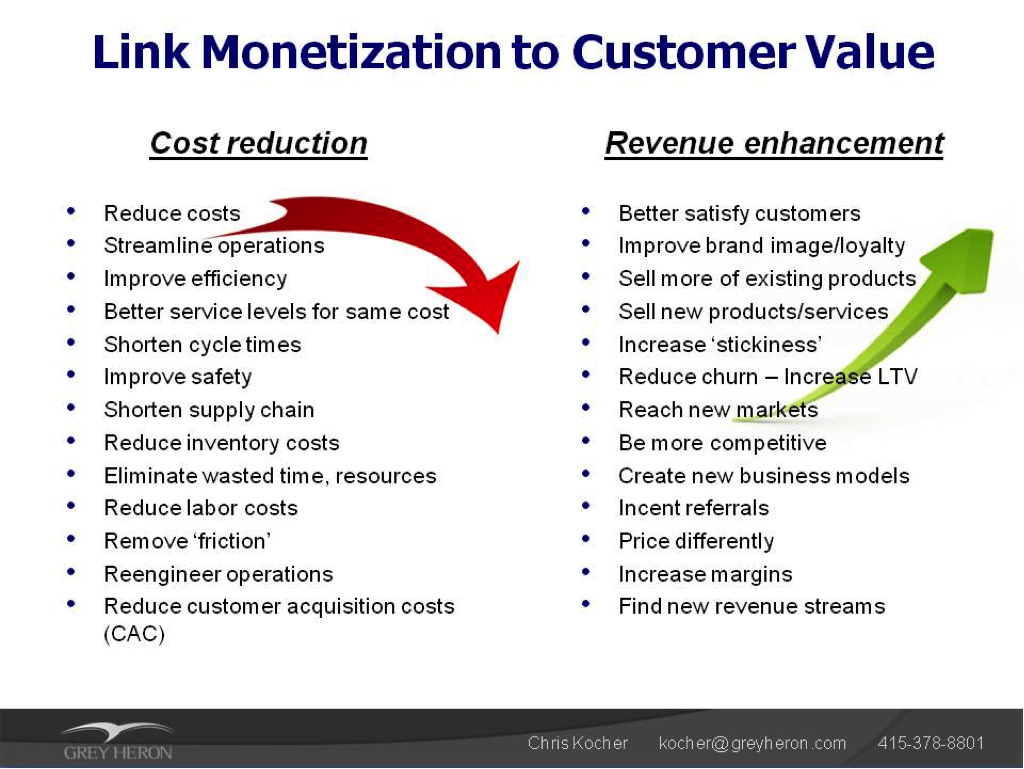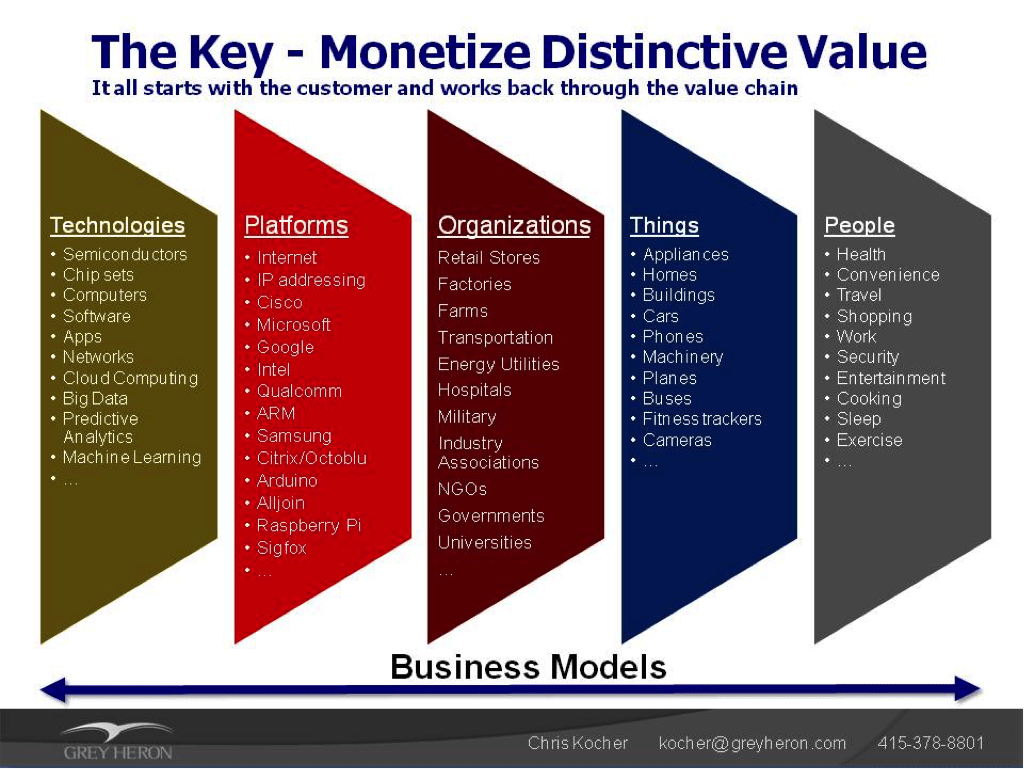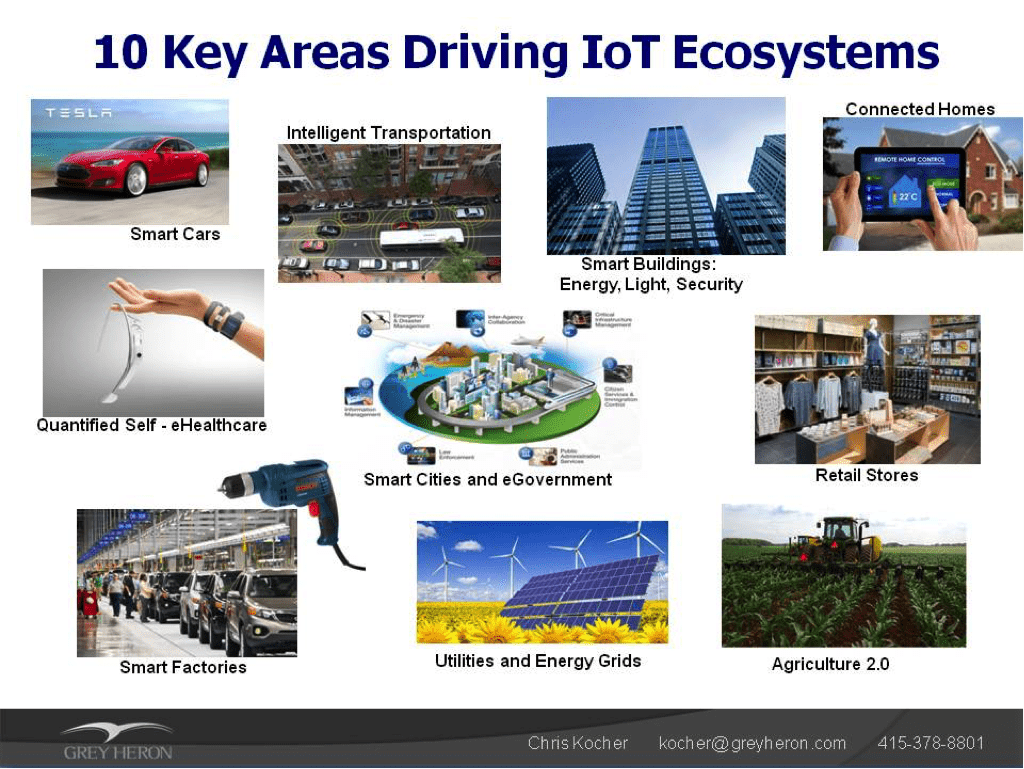
IoT: Where is the money? – Part 1
The Internet of Things (IoT) is growing rapidly, with a forecast of 50 billion connected devices by 2020, according to Cisco. Gartner forecasts over $300 billion in revenues, just to IoT suppliers. And within five years, they estimate one million devices coming online – every hour. Now is the time to figure out how to build and monetize a real business around your IoT innovations.
With hundreds of new products and companies shouting “IoT” every month, there’s no shortage of ideas. Despite this, VisionMobile Developer Economics report data shows “less than 10 percent of IoT developers are making enough to support a reasonably sized team.”
So, while IoT brings new technology, it puts a premium on solving the hard-core business issues of how you can: provide distinctive value, make money, and avoid being disrupted, disintermediated or out-innovated by competitors within your current industry or an adjacent sector.
In this article, I’ll share insights we’ve gained in working with clients that include: the key drivers of IoT, the importance of ecosystems, two key benefits you need in IoT value propositions, monetizing distinctive customer value and seven key considerations for monetizing IoT.
Computing megatrends fuel the IoT monetization opportunity
For 50 years computing costs have plummeted, following Moore’s law, doubling computing capacity and density every 18 months. At the same time, Metcalfe’s law suggests the value of a network grows in proportion to the square of its connections. These two driving forces have given us smaller, faster, more power efficient, cheaper devices connected with speedier, more ubiquitous network connectivity.
As a result, we can cost-effectively monitor, analyze and manage more and more granular “things.” In fact, we don’t even have to be actively involved since machine-to-machine (M2M) technologies are beginning to apply artificial intelligence, machine learning and predictive analytics to make decisions on our behalf.
For example, when my Smartphone’s GPS alerts my connected home that I am nearby, a security webcam could use facial recognition to identify me and then my front door lock could use the Bluetooth signal on my phone for verification and securely open the front door. These types of solutions are here today.
Ecosystems as the driver of value
Although the Internet of Things embodies many areas, 10 main sectors are spearheading adoption. These are depicted in figure 1 which illustrates smart cars, connected homes, wearables, ehealthcare, agriculture 2.0, smart factories, retail stores, smart buildings, utilities and energy grids, intelligent transportation systems and smart cities.
To win in one of these sectors, you have to understand its ecosystem – in detail. That means understanding user behaviors, perceived value, use cases, underlying technologies and market dynamics. And you need to be able to partner with key players as well as compete with alternatives.
Although these sectors are distinct, there is an additional set of overlapping industries that will be greatly impacted. They will provide new markets and targets of opportunity for monetization. They are also ripe for competitive disruption and business model innovation as you can see in just this one example:
Insurance. In smart homes that provide in-depth sensor data from security systems, smoke detectors, thermostats, videocams, people traffic, door locks, etc., insurance companies will be able to better segment their customers to develop entirely new types of property and casualty insurance. In the automotive insurance segment, driverless cars have demonstrated they are safer than human drivers. Will autonomous vehicles have less-expensive insurance? Will Ford, BMW, Tesla and other car companies with superior data on car usage and driver habits in smart cars bundle insurance with their self-driving cars and compete with insurance companies?
It’s interesting to note that many of these IoT technologies, chips, apps, devices, appliances and other “things” have been around for a long time. Most of IoT is not based on breakthrough technology. In reality it’s a remix or mashup of many things that came before. What is fundamentally different and revolutionary are entirely new value-creation opportunities and business models.
Many ways to monetize the IoT opportunity, but no one “right answer”
As my mother always said, “there’s a lid for every pot.” Your business model needs to fit your ecosystem and its occupants.
There are many ways to monetize your IoT offering, whether you’re building a hardware device, developing software as a product or SaaS, offering a new service or creating integrated end-to-end solutions. As an example, here is a small sampling of just one variable you can use in your business model:
Pricing. Ordinary retail and online sales, perpetual licenses, onetime sales, SaaS/PaaS/IaaS, per user/per seat/per company pricing, ad-based business models, subscription-based pricing, freemium models, consulting fees, revenue shares, outcome-based pricing and even the very granular per hour, per transaction or per API call pricing.
Two fundamental benefits you must quantify in your value proposition
Your monetization strategy should be closely linked to customer value. Focus on identifying value creation and benefits around the following areas of cost reduction and revenue enhancement, as shown in figure 2.
All of the above benefits will translate into compelling value propositions, significant brand enhancement, strong use cases and powerful ROIs. The key is to thoroughly analyze and identify which ones can help you monetize your IoT offering.
The key to monetizing IoT: identify distinctive customer value across the value chain
Figure 3 shows a sample diagram of the IoT value chain starting with the customer on the far right and working back all the way to the technologies employed on the left. No matter what type of IoT product or service you offer to individuals or companies, you need to create a map that traces your value back through the value chain. This will also help you clearly identify with whom you should partner in the ecosystem(s).
It‘s very rare for one company or one product to be able to offer the whole solution. And this is why partnering with other players is so important in monetizing IoT. The advantages of working with selected partners in the value chain are shared risk, lower costs, leveraged development, credibility and easier access to markets. In some cases, a partner may be the only way to get into the market. In others, outsourcing non-core components of your solution may also accelerate time to market.
Only by having an integrated value delivery system across the ecosystem’s value chain can you be successful. It means you need to develop robust partner programs, integration expertise (think APIs and SDKs), shared visions and coherent joint sales and marketing programs. In some cases, your integration efforts may need to be a higher priority than new product features.
For example, integration with a dominant platform that most customers use could easily trump all the work you have planned for new functionality. Engineering resources may need to be diverted to reflect these realities. Otherwise, customers may look at your offering and discover it doesn’t work with one of their existing systems, platforms or critical software and simply won’t use it. This is table stakes. Silos of functionality and stand-alone products may not be acceptable.
Seven key considerations for monetizing IoT
In wrapping up this article, I want to share some suggestions based on our work with clients that you may find useful in your IoT monetization journey:
- Intimately understand and quantify the value you are creating for customers/users.
- Build to scale; this is a game of big numbers.
- Deepen and own the customer relationship.
- Collect data, own data, analyze data, monetize data.
- Plan deep integration with ecosystems to reduce friction, speed adoption and create competitive advantage.
- Deliver distinctive, meaningful value to customers.
- Identify alternate ways to better deliver value, e.g., services instead of products.
Align your internal teams and partners to ensure delivery of a coherent, unified IoT offering.
Aligning for success™
